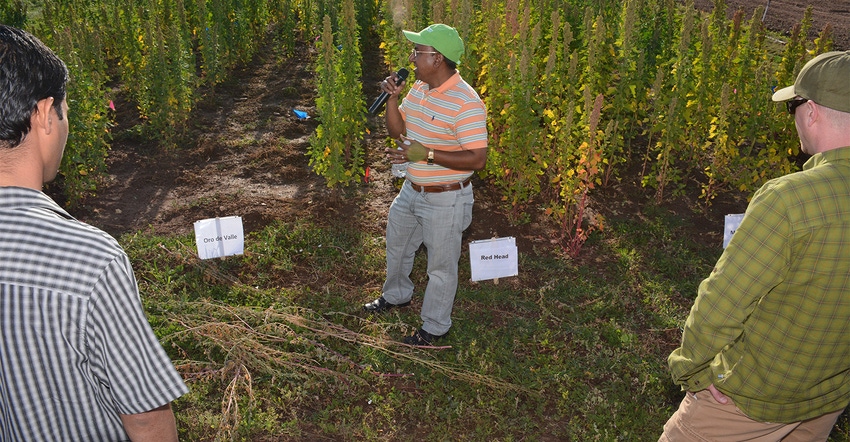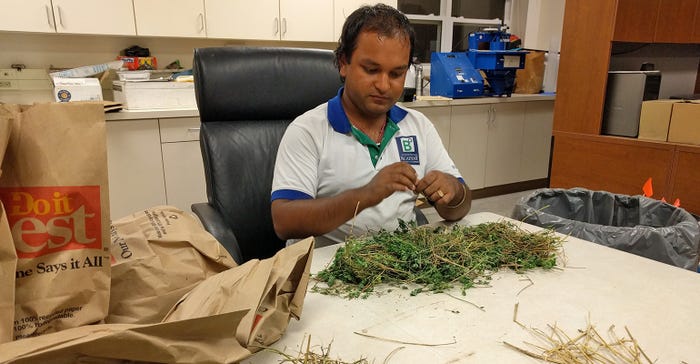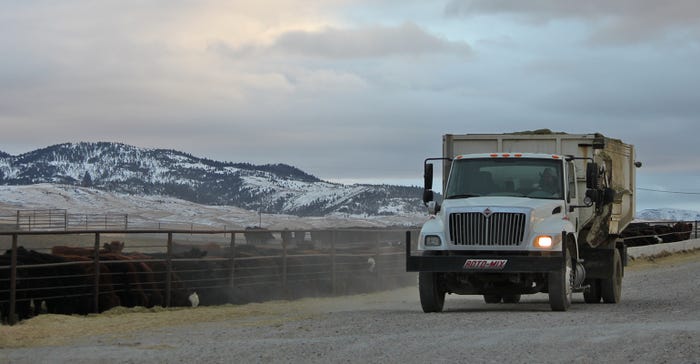July 27, 2017

Studies in Wyoming show that birdsfoot trefoil, fenugreek and quinoa are promising alternative forage crops that producers in the region may want to consider.
“These crops can be successfully grown in Wyoming and similar environments, and have potential to produce reasonable yields,” says Anowar Islam, a University of Wyoming associate professor of forage agroecology.

ANOWAR ISLAM

“Proper time of planting, appropriate cultivar and seeding rates, along with the right time of harvesting are among some important factors to be considered for successful production,” he says. “Controlling weeds is a challenge, but they can be managed if timely measures are taken.”
All of the studies are being conducted in southeast Wyoming, but Islam believes the results could help ranchers and farmers throughout the region with decision-making.
Following are early results from the ongoing research:
Birdsfoot trefoil
This promising forage legume has the potential to increase both the quality and production of livestock forage in Wyoming and surrounding states.

TEST TIME: University of Wyoming graduate student Sayantan Sarkar assembles harvested birdsfoot trefoil plants to determine the dry matter yield of various cultivars. (University of Wyoming)

“It can be used as an alternative to alfalfa due to its non-bloating properties, high persistence and improved forage quality,” says Islam, who, along with graduate student Sayantan Sarkar, is conducting one study under irrigated conditions at the James C. Hageman Sustainable Agriculture Research and Extension Center (SAREC) near Lingle, Wyo. (elevation: 4,176 feet).
Objectives are to determine the effects of planting method, harvesting frequency and cultivars on yield.
Varieties Leo, Norcen and Bruce are being planted in three different field conditions: actively growing winter wheat seeded the previous year, wheat stubble, and a clean-tilled field. Harvesting frequency is either once, twice or three times during the growing season.
“Early results are promising, especially with the plantings in clean-tilled fields that were harvested three times,” Islam says. “Norcen, a native North American high-yielding cultivar, consistently performed well in all planting methods.”
A second study is an on-farm trial near Torrington, Wyo. (elevation: 4,104 feet). “Early results from this project are also promising, especially in terms of harvest frequency [twice] and cultivar performance [Bruce,]” Islam says.
“Bruce is more upright than the other two cultivars; therefore, it is better equipped to outcompete weeds. Also, erect cultivars generally have a better dry matter yield than prostrate types when used for hay production.”
Fenugreek
This leguminous crop is rich in nutrients, but little information is available on its nutritive value and management practices under growing conditions in Wyoming and surrounding states, Islam says.
Four fenugreek entries that are still being studied for possible release (F96, LRC3708, LRC3375 and F75), as well as one previously released cultivar (Tristar), were planted under irrigated conditions at SAREC.
Initial results indicate that the forage quality of fenugreek under growing conditions similar to those in southeast Wyoming is comparable to alfalfa.
Islam and graduate student Saugat Baskota are now focusing efforts on identifying best management practices to enhance yield and quality.
Quinoa
Six cultivars were grown in 2015 and 2016 under irrigated conditions at the Laramie Research and Extension Center (elevation: 7,200 feet). Plants were harvested 96 days after planting in 2015 and 119 days in 2016.
The objective was to determine the forage nutritive value of cultivars Cherry Vanilla, Mint Vanilla, Red Head, Oro de Valle, Brightest Brilliant Rainbow and French Vanilla.
The study, conducted by Islam and Baskota, found that the cultivars were comparable to both corn silage and alfalfa.
“Regardless of the cultivars tested, quinoa has the potential for use as an alternative forage crop for livestock in Wyoming and states with similar growing conditions,” Islam says.
More information about these studies is in the 2017 Wyoming Agricultural Experiment Station Field Days Bulletin; click on the “Publications” link near the bottom of the page.
Updates are expected to be published in the 2018 bulletin, which will be online next summer.

BREAKFAST BREAK: Cattle on the Mussard family’s Reminisce Angus Ranch in Montana receive potato byproducts in their silage mix. (Photo courtesy of Bryan Mussard)

Spud byproducts make great cattle feed
Potatoes make great baked spuds, French fries, potato chips and vodka. They also make excellent feed for cattle.
“When we started adding potato byproducts to our silage in the late 1990s, feedlot performance went up noticeably, and the health of the cattle also improved,” says cattle producer and feeder Bryan Mussard.
Mussard, along with family members and employees, annually trucks about 4,000 tons of potato byproducts from a processing facility in Idaho to the family ranch's feedlot near Dillon, Mont., a round-trip haul of about 300 miles.
“Trucking is very expensive, but I wouldn’t trade the potatoes for just spraying water in the silage, because those potato byproducts [mostly skins] produce silage that has very high nutritional value in terms of phosphorus, protein and energy.”

BRYAN MUSSARD

Mussard says the spud byproducts are wet, and they bind together the dry silage ingredients, including chopped alfalfa hay, barley hay, straw and grain.
“Before I started using potatoes, I would see a lot of silage dust blowing away on windy days, and some of the highest nutrition was in that dust,” Mussard says. “The spuds act like eggs in chocolate chip cookies, holding everything together. That means the cattle can’t sort out the silage ingredients; every mouthful is the same.”
Mussard says that his family’s feedlot backgrounds and develops about 10,000 cattle each year, and the cattle are trucked to Kinsley Feeders in Kansas, where they are finished.
Many of the steers that come to the Mussard feedlot are from customers who purchase the family's registered Angus cows and bulls.
“I am very picky about the vodka we produce with potatoes, and I am equally picky about our cattle. We hang a lot of certified Angus Prime,” Mussard says. “I like to say that I’m a recovering perfectionist.”
Thinking out of the box when it comes to feedstuffs can lead to win-win opportunities for livestock producers and others, says Mussard, who is president of the Montana Stockgrowers Association.
“It’s kind of a neat thing, because 100% of the potato is getting used by us,” he says. “The center of the potato goes into our vodka, and cooked potato peels are for our cattle.”
Turn pre-consumer food waste into livestock feed
Have you ever wondered what happens to vegetable and fruit "waste" at your local grocery stores? It often ends up in the landfill.
Have you ever thought about collaborating with those stores and others to put that waste to good use as a feedstuff for your livestock?
A study funded by the Colorado Department of Agriculture reveals that waste produce from growers, food processors, distributors and supermarkets can be a cost-effective way to supplement cattle feedstuffs.
But all aspects of cost must be taken into account, including hauling, handling and storage costs, spoilage loss, labor and the feed value of the food waste.
If your livestock operation is close to a pre-consumer food waste supply and you can get the food for free, this might be a feasible option to consider.
And in some cases, purchases can even be viable, especially for byproducts such as spent grain, hops and yeast from breweries and distilleries, which are becoming much more common across the West.
For example, one Colorado livestock feeding operation reduced its hay purchases by using barley hulls from a brewery. The barley hulls provide dietary fiber and carbohydrates and cost less than $100 per ton to feed, versus $130/ton for hay and $140/ton for soy hulls.
“Cost is key,” emphasizes the study, which recommends conducting a cost-benefit analysis to help determine the viability of using pre-consumer food wastes, whether waste grains from a local brewery or vegetables and fruits from a grocery store.
Quantifying the cost and benefits of using pre-consumer food waste as livestock feed depends on variables including the type and quality of the food waste, feed value, moisture content, storage time, and distance between the generator and user.
Situation-specific information is necessary to prepare an accurate cost-benefit analysis, says the study, which was conducted by Brink Inc. based in Erie, Colo.
Beyond the potential economic benefits of using food waste in livestock feedstuffs, there is also a “feel-good” benefit by keeping materials out of the landfill and recycling nutrients.
To learn more, see the 21-page food waste for livestock feed report.
Homework pays off with alternative feedstuffs
Many feedstuffs are available to producers across the Western Farmer-Stockman coverage area, from crop residues and processing coproducts to dry beans that are rejected for human consumption.
Finding alternative and unique feedstuffs that provide balanced, least-cost diets for livestock takes a little imagination and ingenuity, combined with research and a willingness to break from the norm.
Many of the alternative feeds vary widely in nutrient content, making an analysis or some assessment of the feed value necessary, says the North Dakota State University Extension Service bulletin "Alternative feeds for ruminants."
Producers must know the energy, protein and major mineral levels of these feeds to determine if they will fit into their feeding program.
With alternative feeds, wet chemistry analysis is recommended. If near-infrared spectroscopy is used, producers should ensure that the laboratory they are working with has calibrated its equipment for their specific feed.
Whatever feed products are used, the ration must be balanced to meet livestock needs and producers' goals on a least-cost basis.
The bulletin discusses more than 100 alternative feedstuffs, including forages, straws, residues, grains and grain coproducts, oilseeds, weeds, coproducts from roots and tubers, as well as liquid coproducts. It also includes a chart that analyzes the nutrient content of these feedstuffs.
Learn more in the 28-page alternative ruminant feeds bulletin.
Another resource is a paper by the University of California Cooperative Extension, which says that alternative feeds are often cheaper than grains and hays in providing energy, protein and bulk filler to a diet. But producers should consider variations in nutrient value, handling requirements and possible nutrient imbalances that can occur from feeding high levels in the diet.
The paper discusses a number of feedstuffs that are available in some locations within the Western Farmer-Stockman readership area, including corn stover, wheat and bean straw, canola and safflower meal, and dry beans.
For example, beans rejected for human consumption can be used in a feedstuff for sheep, and they can also be used in cattle feed provided they are cracked and softened.
To find the article, type the following into your internet find tool: “Use of alternative feedstuffs in your beef operation.”
About the Author(s)
You May Also Like




